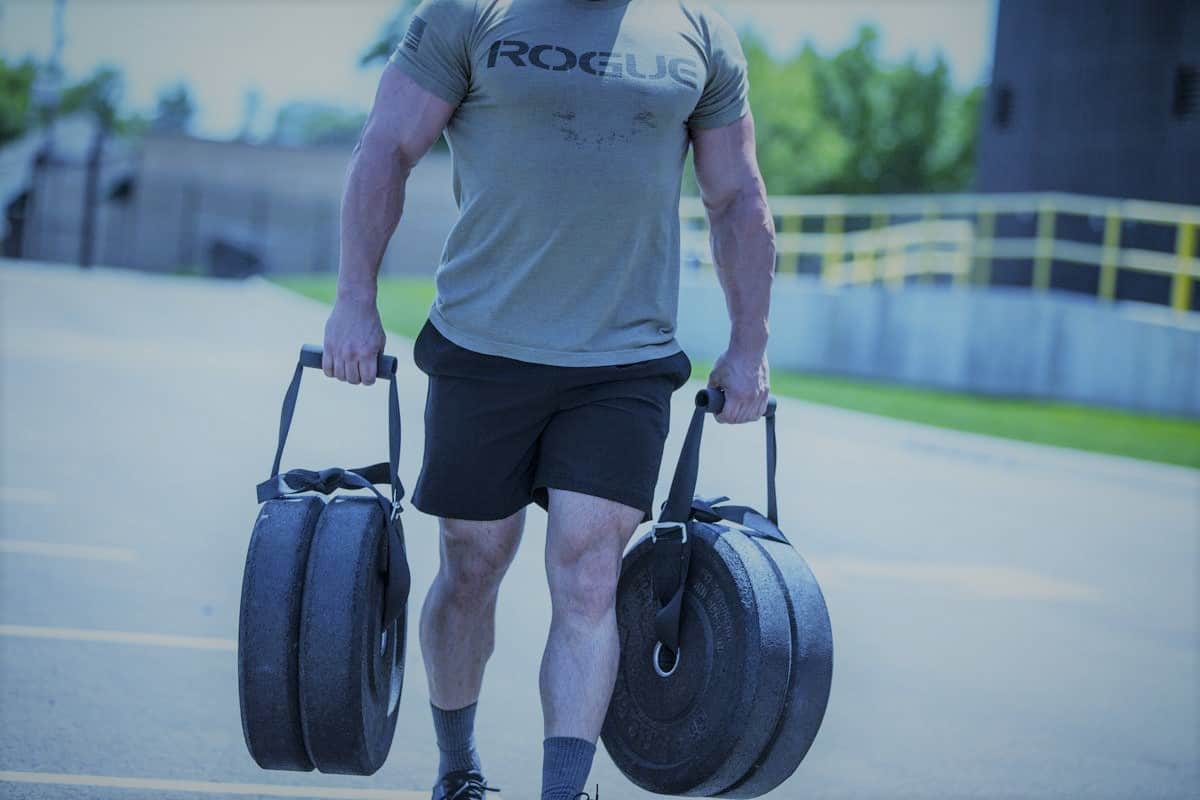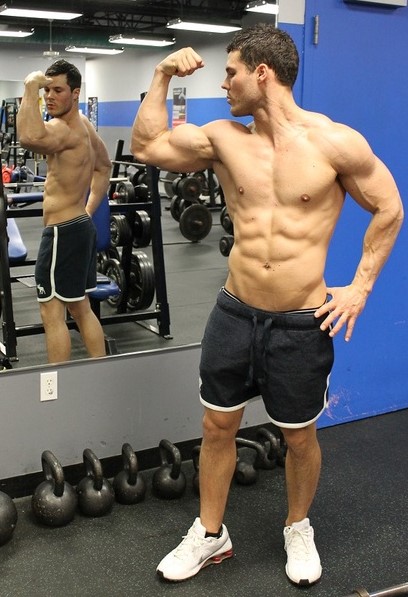Like any lifter, it took a while for me to figure out what I should be doing to supplement my training in the way of physique building. And one of the most useful exercises for building a better-looking body, in my opinion, is the farmer’s walk, otherwise known as the loaded carry.
The loaded carry is not just decent at challenging certain parts of the body that are usually otherwise left not completely challenged by compound lifts, but it’s a decent way to get in a good amount of cardio if you program it right.
I’m going to go over how the loaded carry is performed, what variations you should add into your programming, how often you should do said carry, and why.
What is a Farmer’s Walk/Loaded Carry?
Listen up, bucko – if you’re new to lifting weights, you might be unfamiliar with this idea, but the best way to just train up your strength real fast is to pick up something really heavy and walk around.
 Seriously though, that’s about it. The loaded carry is effective because it’s efficient – you can easily program it to build aerobic and anaerobic capacity, improving your overall work capacity by building your aerobic system in a way that lets you lift more over a longer period of time (which means less overall rest between sets during your workouts, and better recovery after each set), while improving your grip strength, giving you the opportunity to work your calves and trapezius muscles (because who has time for that when you’re squatting and deadlifting?), and building a surprisingly stable core with just a handful of useful variations.
Seriously though, that’s about it. The loaded carry is effective because it’s efficient – you can easily program it to build aerobic and anaerobic capacity, improving your overall work capacity by building your aerobic system in a way that lets you lift more over a longer period of time (which means less overall rest between sets during your workouts, and better recovery after each set), while improving your grip strength, giving you the opportunity to work your calves and trapezius muscles (because who has time for that when you’re squatting and deadlifting?), and building a surprisingly stable core with just a handful of useful variations.
How to do a Farmer’s Walk
As the farmer’s walk implies, all you really have to do is carry around a heavy load. The most standard of these exercises is the simple farmer’s walk, which involves you:
- Standing up straight with a neutral spine, meaning no posterior or anterior pelvic tilt, and no rounded or squeezed shoulders.
- Gripping two weights, one in each hand, starting with something you can walk around the gym with for half a minute or so, and moving up to something you can only do about ten yards with.
- Taking small steps for the heaviest weights (about half a foot), and regular steps with heavy weights (a full foot each time), avoiding long strides unless you’re going for endurance.
- No belts, straps, or accessories. Use a hook grip if you’re not training grip, otherwise take the opportunity to build some forearm muscles.
- Brace your core and take deep breaths. Don’t let your body swing too much to one or the other side – pretend your midsection is a pillar made of solid stone, and don’t let said pillar sway.
The farmer’s walk is either done for distance or weight. Your heaviest farmer walks should still let you take about 10-20 steps. Lighter farmer walks should be at least three times that distance. The heavier the lift, the more it taxes your core. The lighter the lift, the more it taxes the grip, shoulders, and traps.
Useful Variations
Waiter Carry – take a dumbbell or a kettlebell and carry it overhead, with one arm fully extended. Balance the weight so it’s roughly along your centerline and go for a walk. This can challenge your deltoids quite a bit, especially the rear delts, and it’s meant to target the intercostal muscles. Intercostal muscle strain is quite a common occurrence, so building a stronger intercostal wall can offer you injury resistance, plus help you build a stronger and more stable upper body in the overhead press and front squat.
Uneven Carry – this is a pretty simple variation on the loaded carry, and just involves picking up two differently-weighed weights. I’m not a huge fan of this one, but it’s a variation some people tout, so I’ll list it anyway. The reason I don’t find it particularly effective is because you should just do:
Suitcase Carry – this one is great, and very simple to execute. All you have to do is pick up a heavy dumbbell and keep your body straight. Try to flare your lats a little and keep the weight just a few inches from your waist. This will force you to engage your core even more. Don’t go too heavy – the idea is to challenge the core, so if you pick up a weight that’s too heavy for you walk around straight, you’re basically wasting time. Stick to the really heavy stuff for the farmer’s walks – for a good core workout, use a weight that’ll challenge you but won’t cause you to buckle.
Get Creative
Ever noticed when you say the word “carry” over and over again it kind of starts to lose its meaning? Carry, carry, carry. That’s called semantic satiation, and it has something to do with how the brain is simultaneously firing two different processes at once, leading to the “reduction of the intensity of an activity through repetition”.
When lifting heavy weights, the same thing applies. Eventually, you’ll run into a problem wherein something just doesn’t feel heavy, so you need to go heavier – progressively overloading in order to gain strength and muscle.
But what if you’re out of dumbbells? Most gyms don’t have a large repertoire of odd bars, so I don’t blame you if you’ve run into the issue of not having farmer’s grips. If the heaviest dumbbells in the gym are too light for you, try and find the tricep bar. That’s a bar with two neutral grips on it, used for tricep extensions. You can load that bar up and do suitcase carries with it. If you find two, even better – go to town.
The Case for Suitcase Deadlifts
Another interesting variation that isn’t a carry but does confer some amazing core development is the much heavier (and highly undervalued) suitcase deadlift. That’s exactly what it sounds like – load up either said tricep bar or a proper 45lbs barbell with 30% of your 1RM deadlift and pick it up.
Go up from there and see where your limit lies. Remember that this is a core exercise – keep your lats engaged, your core tight, your arms in a dead hang, keep the center of the bar aligned with the center of your body, and pick it up while maintaining a perfectly rigid torso. Don’t allow your body to bend to the side. This isn’t a one-armed deadlift, it’s more of a… side-lift.
Suitcase deadlifts are best incorporated as a core accessory at the end of a leg day workout. Go for a lighter weight and go for 10-12 repetitions if you want to also turn it into a unilateral leg exercise – you’ll get a little bit of quad activation. First and foremost, though, this is an exercise to target the obliques and build a sturdier core and back, especially for heavy deadlifts. I absolutely adore this exercise, and it’s a decent way to train your grip as well.
Programming Loaded Carries
I personally suggest working loaded carries into whenever you’re training your core. If you don’t train your core, make a habit of doing so. What I do is train my squat and deadlift twice a week, and I do overhead and pressing work on the other three days. I start each day with a few prehab exercises and some light core work, but I end the three upper body days with four to six sets of carries, using two variations per day, usually cycling between suitcase, waiter, and farmer’s carries. Consider running:
- Monday: Farmer’s Carry, Suitcase Carry
- Wednesday: Suitcase Carry, Waiter Carry
- Friday: Farmer’s Carry, Waiter Carry
Or any similar variation.
You’ll greatly benefit from weighted carries in the squat, deadlift, and overhead press, especially as a beginner. You need a strong core and back in order to lift heavier weights, and while lifting heavy in itself does a good job of helping you improve in these areas, your abdominal wall typically could use some more work. The bonus, of course, is bigger traps and bigger forearms.




